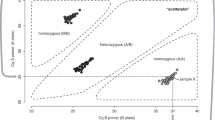Abstract
Single nucleotide polymorphisms (SNPs) represent the most abundant source of genetic variation in the human genome, and they can be linked to genetic susceptibilities or varied pharmaceutical responses. Established SNP detection techniques are mainly PCR-based, which means that they involve complex, labor-intensive procedures, are easy contaminated, and can give false-positive results. Therefore, we have developed a simple and rapid MS-based disulfide barcode methodology that relies on magnifying the signal from a dual-modified gold nanoparticle. This approach permits direct SNP genotyping of total human genomic DNA without the need for primer-mediated enzymatic amplification. Disulfides that are attached to the gold nanoparticle serve as a “barcode” that allows different sequences to be discerned using MS detection. Specificity is based on two sequential oligonucleotide hybridizations, which include two steps: the first is the capture of the target by gene-specific probes immobilized onto magnetic beads; the second is the recognition of gold nanoparticles functionalized with allele-specific oligonucleotides. The sensitivity of this new method reaches down to the 0.1 fM range, thus approaching that of PCR. The feasability of this SNP identification methodology based on an MS-based disulfide barcode assay was demonstrated by applying it to genomic DNA samples representing all possible genotypes of the SNPs G2677T and C3435T in the human MDR1 gene. Due to its great advantage—the ability to perform SNP typing without the use of PCR—the assay was found to be simple, rapid and robust, and so may be highly suited to routine clinical detection as well as basic medical research.

SNP typing procedures of the MS-based disulfide-barcode assay




Similar content being viewed by others
References
Riva A, Kohane IS (2004) BMC Bioinform 5:33
Salisbury BA, Pungliya M, Choi JY, Jiang RH, Sun XJ, Stephens JC (2003) Mut Res Fundam Mol Mechan Mutagen 526:53
Bao YP, Huber M, Wei TF, Marla SS, Storhoff JJ, Muller UR (2005) Nucleic Acids Res 33:e15
Glinsky GV (2008) Cell Cycle 7:2570
Myakishev MV, Khripin Y, Hu S, Hamer DH (2001) Genome Res 11:163
Song P, Meibohm B, Gaber AO, Honaker MR, Kotb M, Yates CR (2002) Clin Pharmacol Ther 71:103
Georgiana DC, Alexandra SG, Nicoleta C, Stanciu F, Dobre M, Dorina B, Rodica T, Cristea P, Veronica S (2009) Rom Biotechnol Lett 14:4845
Wang WP, Ni KY, Zhou GH (2006) Chem J Chin Uni Chinese 27:1856
Mirkin CA, Letsinger RL, Mucic RC, Storhoff JJ (1996) Nature 382:607
Niemeyer CM (2001) Angew Chem Int Ed 40:4128
Toubanaki DK, Christopoulos TK, Ioannou PC, Gravanis A (2008) Appl Pharmacogenet Anal 275:367
Stoeva SI, Lee JS, Smith JE, Rosen ST, Mirkin CA (2006) J Am Chem Soc 128:8378
Stoeva SI, Lee JS, Thaxton CS, Mirkin CA (2006) Angew Chem Int Ed 45:3303
Palegrosdemange C, Simon ES, Prime KL, Whitesides GM (1991) J Am Chem Soc 113:12
Houseman BT, Gawalt ES, Mrksich M (2003) Langmuir 19:1522
Wu LL, Qiu LW, Shi CS, Zhu J (2007) Biomacromol 8:2795
Qiu F, Jiang DW, Ding YB, Zhu J, Huang LL (2008) Angew Chem Int Ed 47:5009
Grabar KC, Freeman RG, Hommer MB, Natan MJ (1995) Anal Chem 67:735
Frens G (1973) Nature Phy Sci 241:20
Nam JM, Stoeva SI, Mirkin CA (2004) J Am Chem Soc 126:5932
Hill HD, Mirkin CA (2006) Nat Protoc 1:324
Jin RC, Wu GS, Li Z, Mirkin CA, Schatz GC (2003) J Am Chem Soc 125:1643
Storhofff JJ, Elghanian R, Mirkin CA, Letsinger RL (2002) Langmuir 18:6666
Hurst SJ, Lytton-Jean AKR, Mirkin CA (2006) Anal Chem 78:8313
Wang NL, Zhang P, Guo XJ, Xie J, Huo R, Wang FQ, Chen L, Shen J, Zhou ZM, Shi QH, Zhao BG, Sha JH (2009) Proteomics 9:3425
Zhang Y, Shuang SM, Dong C, Lo CK, Paau MC, Choi MMF (2009) Anal Chem 81:1676
Tang J, Liu YC, Qi DW, Yao GP, Deng CH, Zhang XM (2009) Proteomics 9:5046
Sommer SS, Groszbach AR, Bottema CDK (1992) Biotech 12:82
Acknowledgements
This work was supported by the Scientific Research Foundation for Returned Overseas Chinese Scholars from the Education Ministry of China (No. 0214168001), the National Natural Science Foundation of China (Grant 20975113), and the National Key Science and Technology Special Project (2008zxj09014-012). We thank Dr. Erol Gulcicek of Yale University for his critical review of our manuscript. We also wish to acknowledge Fuqiang Wang for his technical assistance in the MALDI-TOF mass spectrometry detection experiments.
Author information
Authors and Affiliations
Corresponding authors
Rights and permissions
About this article
Cite this article
Yang, B., Zhou, G. & Huang, L.L. PCR-free MDR1 polymorphism identification by gold nanoparticle probes. Anal Bioanal Chem 397, 1937–1945 (2010). https://doi.org/10.1007/s00216-010-3750-4
Received:
Revised:
Accepted:
Published:
Issue Date:
DOI: https://doi.org/10.1007/s00216-010-3750-4




